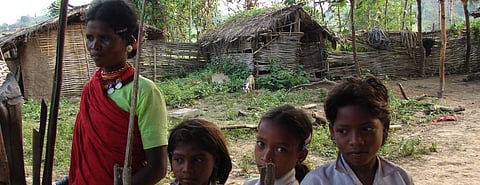Here are some solutions to address health challenges faced by tribal communities
This blog has been updated
In India, 8.6 per cent of the total population, or 104 million people, belong to tribal communities. The tribal communities are primarily settled in rural and remote areas and are among the most vulnerable and marginalised groups.
They disproportionately suffer from ill health and malnutrition. For instance, the prevalence of tuberculosis (TB) among them is almost three times higher than the national average — 703 per 100,000 compared to the national average of 256 per 100,000.
Malaria and malnutrition are other scourges that disproportionately affect the tribal communities. In recent decades, increasing stress levels, as well as changing food patterns, are also leading to an increase in non-communicable diseases that are often referred to as lifestyle diseases.
Tribal populations have predisposition to a few specific afflictions such as sickle cell anaemia which is hereditary in nature but other diseases like malnutrition and respiratory disorders are largely attributable to their living and working conditions.
Moreover, limited access to nutritious food and healthcare, coupled with heavy and hazardous work, put them at high risk of early death, disability and malnutrition.
Dwindling forests, declining water tables and rising food costs make it difficult for them to access affordable, nutritious food. A study conducted among tribal communities of southern Rajasthan showed that the consumption of proteins and oils by children from tribal families is much below the levels required to stay nourished.
When a person from the tribal population falls ill, it is difficult to access healthcare since healthcare facilities are far away and understaffed. For example, 84 per cent of positions of specialist doctors and 33 per cent of graduate doctors are vacant in 10 states with a sizable tribal population.
Interestingly, however, there is a surplus of Auxiliary Nurse Midwife (ANM) — 64 per cent more ANMs are posted than sanctioned. Existing healthcare providers are also often not sensitive to the needs of the tribal population, nor are they well versed with their regional dialects, limiting their ability to communicate with the tribal populations and build trust.
A large proportion of tribal families, especially young men, migrate to cities and work as manual labourers, where the hazardous living and working conditions make them vulnerable to diseases such as TB. The city health system is also often not friendly to the needs of the migrant populations.
The Government of India constituted an expert committee on tribal health, which recommended that the government's per capita expenditure on tribal health should be substantially enhanced. It recommended that 70 per cent of this should be spent on primary health care.
This recommendation should be immediately implemented. Such increased outlays should be used for expanding easy-to-access primary healthcare centres (PHC), which are managed by healthcare providers from tribal communities.
Greater autonomy, skilling and support to nurses and sourcing of ANMs posted in these PHCs from the tribal communities will help in ensuring the provision of responsive healthcare.
AMRIT Clinics, managed by Basic Health Care Services, nurse-led primary healthcare services in tribal Rajasthan is one such example.
When complemented with greater skilling and autonomy for community health workers, such as ArogyaMitras promoted by the SEARCH foundation, a non-profit) at Gadchiroli, the dream of responsive and comprehensive healthcare for tribal populations can become a reality.
For those requiring emergency referrals, a referral transport system having a fleet of vehicles which can navigate the hilly terrains should be deployed at suitable locations for the timely transfer of patients to higher-level hospitals.
Currently, only 108 ambulances are in place and they cannot typically withstand the road conditions in the tribal terrain.
For specialised non-emergency care, PHCs in these areas could be equipped with telemedicine but with expertise from specialists who understand the tribal milieu as well as epidemiology.
Improving access to healthcare should be supplemented with efforts to improve nutrition, one of the most critical determinants of health in these populations.
Setting up day-care-centres for young children, like Phulwaris run by several NGOs across tribal areas, including pulses and oil in the Public Distribution System as being done in Chhattisgarh and promoting the growth of nutritious food, such as millets, locally are some ways by which nutrition security and outcomes could be improved.
Finally, we need to invest in making living and working spaces safe for vulnerable migrant workers in cities, a large proportion of whom are tribals. Affordable and safe housing and enforcement of safety standards will go a long way in promoting the health of some of the most vulnerable tribals and their families.
Read more:
Pavitra Mohan is the co-founder and director at Basic HealthCare Services, Udaipur
Shweta Jaiswal is a senior healthcare professional with over 18 years of experience as an Anaesthetist and Intensivist
DVR Seshadri is a Professor at the Indian School of Business
Views expressed are the authors’ own and don’t necessarily reflect those of Down To Earth

